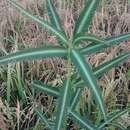ar
الأسماء في صفحات التنقل


Soft spongy stems known as Sola are used in hats, floats and are also used as lint.
Aeschynomene aspera is a species of flowering plant in the family Fabaceae. It is also known by the names sola (Odia ସୋଲ), shola (Bengali শোলা) sola pith plant, pith plant, laugauni (Hindi)[1] ponguchedi (Malayalam)[2] or Netti (Tamil).[3] Pith of low density from this plant is used to make hats known as pith helmets or sola topis.
It is native to Bangladesh, Bhutan, Cambodia, India, Indonesia, Laos, Malaysia, Myanmar, Nepal, Pakistan, Sri Lanka, Thailand, and Vietnam.
It is an aquatic plant and is considered a minor weed of rice paddies across its range.[4]
From the biological viewpoint, the used part is the wood of the stem (often mistaken as pith, but it is not).[5]
Aeschynomene sp. woods is one of the lightest woods in the world.[6][7][8] Aeschynomene woods feel like a piece of expanded polystyrene or even lighter, and have a corky texture. It is bright white to off-white (white with a slight reddish or yellowish tinge) in color.
This corky material is used to make some traditional Indian crafts and artworks, and also decorative objects for worship, etc.
The young leaves and flowers are eaten in salads during times of famine in Cambodia, where the plant is known as snaô 'âm'bâhs (snaô="edible flowers", 'âm'bâhs="filamentous", Khmer language).[9] In local medicine in Cambodia, it is used to treat uterine bleeding.
Aeschynomene aspera is a species of flowering plant in the family Fabaceae. It is also known by the names sola (Odia ସୋଲ), shola (Bengali শোলা) sola pith plant, pith plant, laugauni (Hindi) ponguchedi (Malayalam) or Netti (Tamil). Pith of low density from this plant is used to make hats known as pith helmets or sola topis.
It is native to Bangladesh, Bhutan, Cambodia, India, Indonesia, Laos, Malaysia, Myanmar, Nepal, Pakistan, Sri Lanka, Thailand, and Vietnam.
It is an aquatic plant and is considered a minor weed of rice paddies across its range.
Rút nhám, rút dại hay điền ma nhám (tên danh pháp hai phần: Aeschynomene aspera) là một loài thực vật có hoa thủy sinh thuộc họ Fabaceae. Ruột cây rút nhám rất xốp và nhẹ, có tính cách nhiệt nên được dùng làm cốt mũ và nón, nhất là loại nón thuộc địa mà tiếng Việt thường gọi là nón cối.
Bản địa của cây rút nhám là Bangladesh, Bhutan, Campuchia, Ấn Độ, Indonesia, Lào, Malaysia, Myanma, Malaysia, Nepal, Pakistan, Sri Lanka, Thái Lan, and Việt Nam. Cây rút mọc hoang ở những vùng đất trũng, ven ao hồ, ruộng ngập kể cả vùng nước lợ.[1]
|coauthors= bị phản đối (trợ giúp)
Rút nhám, rút dại hay điền ma nhám (tên danh pháp hai phần: Aeschynomene aspera) là một loài thực vật có hoa thủy sinh thuộc họ Fabaceae. Ruột cây rút nhám rất xốp và nhẹ, có tính cách nhiệt nên được dùng làm cốt mũ và nón, nhất là loại nón thuộc địa mà tiếng Việt thường gọi là nón cối.
Bản địa của cây rút nhám là Bangladesh, Bhutan, Campuchia, Ấn Độ, Indonesia, Lào, Malaysia, Myanma, Malaysia, Nepal, Pakistan, Sri Lanka, Thái Lan, and Việt Nam. Cây rút mọc hoang ở những vùng đất trũng, ven ao hồ, ruộng ngập kể cả vùng nước lợ.